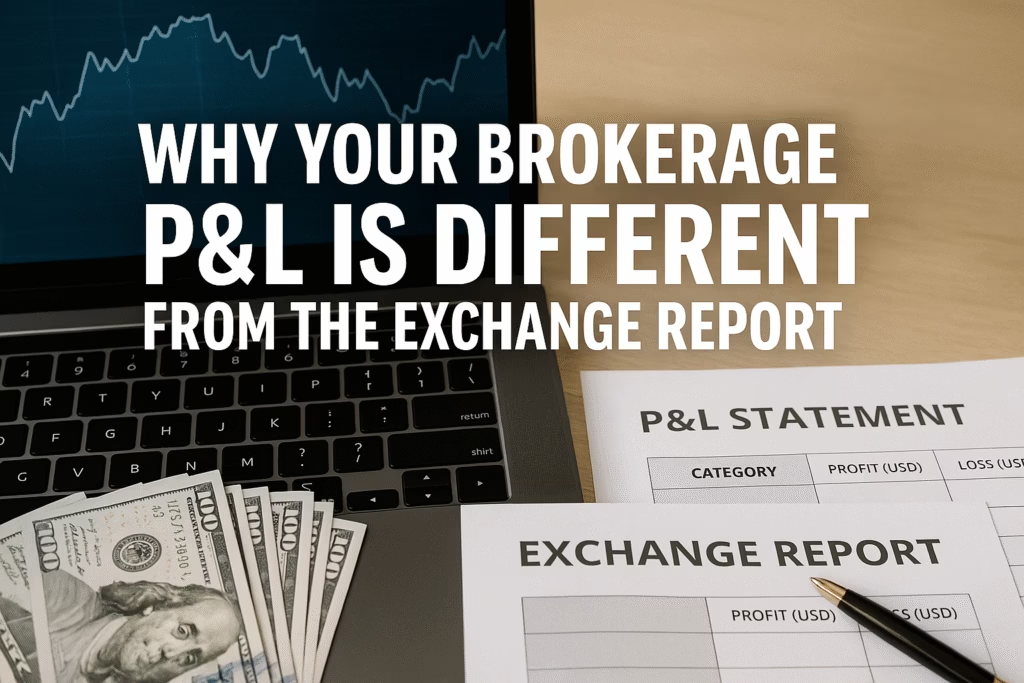🚨 Introduction: The Confusion Retail Traders Don’t Talk About
If you’ve ever placed trades in the stock market and later checked your broker’s profit and loss (P&L) report, you might have noticed something strange—the numbers don’t match the exchange report. You’re not alone. Thousands of retail traders face this brokerage P&L mismatch regularly, but few truly understand why it happens.

The confusion can cost you—mentally and financially. In this article, we’ll break it down in plain English, backed by real scenarios. We’ll also show you how to reconcile the numbers and never get blindsided again.
🔍 What Is a Brokerage P&L, and How Is It Calculated?
Your brokerage P&L (profit & loss) is a detailed breakdown provided by your trading platform. It tells you how much you’ve earned or lost from your trades.
However, this figure isn’t just about the price you bought and sold at. It includes:
- Brokerage charges
- Exchange transaction charges
- SEBI fees
- STT (Securities Transaction Tax)
- GST on brokerage
- Stamp duty
- Call & Trade fees (if any)
Each of these charges can change how your brokerage P&L mismatch appears when compared to the exchange report.
🏦 What Is an Exchange Report?
The Exchange Report is issued by clearing corporations like NSCCL (for NSE) or ICCL (for BSE). It records only the net settlement value of your trades. It does not factor in your broker’s charges, platform fees, or intraday square-off penalties.
So when you compare the exchange report to your broker’s P&L—boom! A brokerage P&L mismatch.
⚖️ Real-Life Example of a Brokerage P&L Mismatch
Let’s say you made the following trade:
- Bought 100 shares of ABC Ltd. at ₹100
- Sold 100 shares of ABC Ltd. at ₹105
You expect a profit of ₹500, right?
But your brokerage P&L shows a net profit of only ₹438.50.
Why?
Because the remaining ₹61.50 was eaten up by:
- Brokerage: ₹20
- STT: ₹15
- GST: ₹9
- Exchange Fee: ₹2
- SEBI Fee: ₹1
- Stamp Duty: ₹1.50
- Other Charges: ₹13
Your exchange report still shows a profit of ₹500—because it doesn’t include these fees.
This is a textbook case of a brokerage P&L mismatch.
“Buy the Dip Strategy: Why Retail Investors Keep Getting It Wrong (And How to Fix It)” 2025
🧾 List of Charges That Cause P&L Mismatch
Here’s a breakdown of the charges that usually trigger mismatches:
| Charge Type | Included in Exchange Report? | Included in Broker P&L? |
|---|---|---|
| Brokerage Fees | ❌ No | ✅ Yes |
| STT | ❌ No | ✅ Yes |
| Exchange Transaction | ❌ No | ✅ Yes |
| SEBI Charges | ❌ No | ✅ Yes |
| Stamp Duty | ❌ No | ✅ Yes |
| DP Charges | ❌ No | ✅ Yes |
| Platform Fees | ❌ No | ✅ Yes |
Knowing this helps you decode the brokerage P&L mismatch easily.
🛠️ How to Fix or Reconcile Brokerage P&L Mismatches
✅ Step 1: Download Both Reports
- Get your broker’s P&L statement from the app or website.
- Also download the exchange’s contract note or trade report.
✅ Step 2: Compare Gross Trade Values
Match the quantity and value of trades across both reports. Ensure both show the same transaction volumes.
✅ Step 3: Manually List Charges
Make a table of all charges applied by your broker—include every rupee deducted.
✅ Step 4: Subtract Charges from Exchange Profit
Now subtract all charges from the gross profit in the exchange report. It should match your broker’s P&L figure.
This is how you manually fix the brokerage P&L mismatch and validate your actual profits.
🤔 Why Do Brokers Show “Different” P&L Figures in Different Reports?
Most brokers offer multiple reports:
- Trade Book
- P&L Report
- Tax P&L
- Ledger Report
Each report shows slightly different numbers because of accounting standards and inclusion/exclusion of taxes.
For instance, the tax P&L may ignore unrealized gains/losses. The ledger may include fund transfers, margins, or interest.
This is another subtle reason behind a brokerage P&L mismatch.
🔍 Intraday vs Delivery: Mismatch Triggers Change
The type of trade matters:
| Trade Type | Common Issues That Skew P&L |
|---|---|
| Intraday | Square-off charges, auto-closure penalties |
| Delivery | DP Charges (₹13.5 – ₹25 per transaction), GST |
The charges vary not just by segment (equity, futures, options), but also by broker policy. That’s why brokerage P&L mismatch can be inconsistent across platforms.
⚠️ Common Scenarios Where P&L Mismatch Hurts You
- Filing ITR with Wrong P&L
Using your exchange report for ITR without broker adjustments can lead to audit triggers. - Capital Gains Misreporting
You may under-report capital gains if DP charges aren’t accounted for. - Confusion in Tax Loss Harvesting
Some brokers show FIFO-based P&L, while exchanges follow trade date—leading to error in tax loss decisions.
All these are consequences of not understanding the brokerage P&L mismatch.
💡 Tips to Avoid Future Confusion
- Always check the tax P&L and not just the trading P&L for year-end filing.
- Download the contract note after every trade.
- Use brokerage calculators to cross-verify charges.
- Ask your broker for a charges breakup if it’s unclear.
- Keep a basic Excel of your trades and net profits.
The more you track, the better you understand the brokerage P&L mismatch pattern.
Why Your Stock Didn’t Move Despite Good Earnings: Understanding the Stock Price Reaction
🧠 Final Thoughts: It’s Not a Glitch, It’s How the System Works
At first glance, the brokerage P&L mismatch looks like a bug. But it’s actually a feature—a result of layered accounting across entities.
- Exchanges report only trade data.
- Brokers report financial impact.
- Only when you merge both do you see the full picture.
Being informed is your best defense. Next time you see a mismatch, you’ll know it’s not an error—it’s expected. And now, you’ll know how to fix it.
🏁 TL;DR
- The brokerage P&L mismatch occurs due to platform-specific charges not included in exchange reports.
- Intraday delivery and F&O trades all have different charges.
- Always reconcile exchange data with broker charges before filing taxes or analyzing performance.
- Use the tax P&L for ITR—not raw exchange reports.


[…] parameters help isolate fundamentally sound smallcaps, not just speculative […]